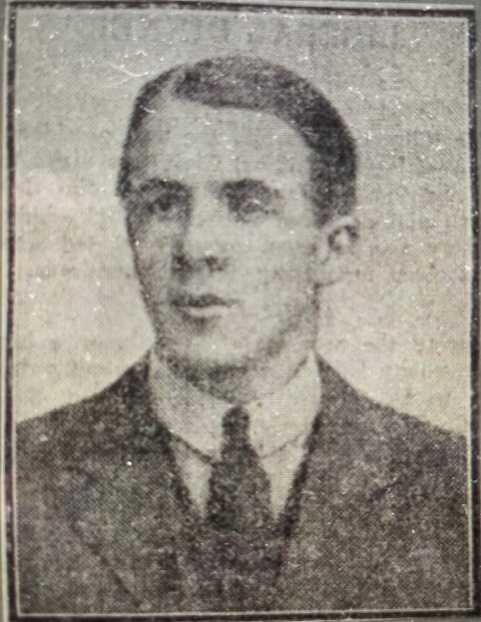Great War Dundee
This is Dundee's story of those that served in the First World War, and of the people left at home
Charles Reid Cleghorn
Military Information
- Date of enlistment: 07.09.1914
- Place of enlistment:
- Service no: N/A
- Rank: Captain
- Service Occupation:
- Awards: Military Cross
- Regiment/Service: Duke of Cambridges Own (Middlesex) Regiment
- Unit/Ship: 16th Battalion
Personal Information
- Date of Birth: 30.09.1890
- Place of Birth: Dundee
- Address: Westerton of Craigie, Dundee
- Occupation: William Cleghorn Ltd, Clepington Works, Dundee
- Mother:
- Father:
William Cleghorn
- Siblings:
- Spouse:
Kathleen Isobel Jane Briggs
- Children:
- Age at Death: 82
- Date of Death: 09.12.1972
- Place of Death: Fernbrae Nursing Home, Dundee
- Burial Country:
- Cemetery:
More about Charles Reid Cleghorn
An excellent First Day of The Somme related Military Cross to Lieutenant Charles Reid Cleghorn, 16th (Public Schools) Battalion, Middlesex Regiment.
The MC was awarded for leading a near suicidal patrol on the night of 27/28 June 1916. This was to check on the strength of the German trenches and to report on damage to the enemy’s wire following the blistering British artillery barrage on the German lines immediately prior to the first day of the battle of the Somme.
Later wounded at Arras in 1917 – shrapnel wound to the right eye.
Charles Reid Cleghorn was born in Dundee on 30 September 1890, son of William Cleghorn a prominent Dundee jute manufacturer. Charles was educated at Clifton College, Bristol. He was employed by J.F. Low & Co. Ltd at Monifieth (1908-10). By 1914 he was working at the family business, ‘Cleghorn Ltd’ at the Clepington Works in Dundee which was owned by his father.
Not long after the outbreak of war, on 7 September 1914, he enlisted into the newly formed ‘public schools’ battalion of the Middlesex Regiment at St James Street, London. He was 23 years old, 6 feet tall, 11 stone 12 lbs, with grey eyes and brown hair. He was medically examined the next day and passed fit. Cleghorn was promoted Corporal on 15 September, Lance Sergeant on 7 October and Sergeant on 14 October 1914. The Battalion was initially based at Kempton Park racecourse. In December 1914 it moved to Woldingham.
The commanding officer recommended Cleghorn for a commission. He was commissioned into the Middlesex Regiment as Second Lieutenant on 28 January 1915. He remained with the battalion, which became the 16th (Public Schools) Battalion of the Middlesex Regiment. In July 1915 the Battalion moved to Clipstone Camp and in August 1915 to Perham down. Cleghorn was promoted Lieutenant on 22 October 1915.
On 17 November 1915, after a year training in England, the 16th Middlesex embarked for France landing at Boulogne. Cleghorn served in France with the 16th Middlesex France from November 1915. In late June 1916 preparations were being made for the Battle of the Somme.
Military Cross: War Diary
On 15 June 1916 the Battalion took over trenches in AUCHENVILLERS. On 23 June they marched to ACHEUX WOOD.
On 27 June the order was given for a general assault on the enemy’s trenches on 29 June [note: this date was originally scheduled to be the first day of the Battle of the Somme; it was later postponed by 2 days to 1 July]. The 16th Middlesex was to go over the top.
The day before the planned ‘first day’ assault, the commanding officer of the 16th Middlesex wanted to see what they would be facing when the battalion went over the top. This required a very dangerous (almost suicidal) patrol. It was to be led by a very small number of soldiers, led by a single officer. That officer was Cleghorn. He probably volunteered to lead the patrol.
The War Diary records:
‘Night of 27/28 June:
LT CLEGHORN and 12 other ranks carried out a raid on the enemy’s trenches. At 11.10 pm the party left our trenches. After getting through our own wire the party moved along NEW BEAUMONT ROAD up to the enemy’s trenches unobserved. They found the enemy’s wire considerably damaged but with no clear passage through it.
This held the party up and only the officer [CLEGHORN] and 2 men got through and entered the German trenches. At this moment the enemy began throwing bombs into their front trench from both flanks and into their wire. They also opened up a heavy machine gun fire and made a barrage of shrapnel on our front line and on the sunken road.
The officer [CLEGHORN] gave the word to withdraw and the party returned to our own lines. Casualties: 2 other ranks wounded.
On 28 June orders were received postponing the general assault from June 29th to July 1st.’
Cleghorn was awarded an immediate Military Cross for this patrol. London Gazette 22 September 1916 – 1 July 1916 – First Day of the Somme
‘For conspicuous gallantry. He raided the enemy’s front trench with a small party to see if it was strongly held, forcing his way through the wire with great difficulty. He showed the greatest determination under rifle, grenade and bomb fire.’
On 1 July the 16th Middlesex were facing the German trenches at HAWTHORN RIDGE redoubt, Beaumont Hamel. At 7.20 am the British exploded a huge mine beneath the German defences. Ten minutes later, at 7.30 am, the 16th Middlesex went over the top and attacked.
The 16th Middlesex lost 22 officers and 500 men (killed, wounded or missing). These astonishing figures were among the highest casualties of any battalion that day.
Cleghorn was lucky to survive. The next day – 2 July 1916 he was promoted Captain. This was probably due to the heavy losses on 1st July. He remained with the 16th Middlesex in France. Almost a year later he took part in the battle of Arras.
Battle of Arras – wounded on 30 May 1917
On 30 May 1917, the 16th Middlesex were at MONCHY-LL-PREUX. They attacked the German position known as HOOK TRENCH under an intense artillery barrage. The battalion lost 8 officers and 246 men (killed, wounded or missing) in the attack.
Captain Cleghorn was wounded by fragments of shell in the right eye and was nearly blinded in that eye. He was evacuated back to England, where he spent some time in hospital. A medical board on 21 August 1917 at 2nd London General Hospital, King’s Road Chelsea. Found that ‘… he was wounded by fragments of shell in right eye and eyelid. In addition to this he suffered injuries to the chest and both knees.’ He was not fit for general service.
Cleghorn was attached to the Training Reserve between 24 October and 14 December 1917. He was subsequently attached to the 5th (Reserve) Battalion, Middlesex Regiment. He remained on home service. A further medical board was held at Chatham on 26 August 1918. Cleghorn had almost completely recovered from his injury and the board found him ‘Fit for general service.’ But by this time the war was almost over.
Captain Cleghorn relinquished his commission on 21 January 1919. He was released from the 5th (Reserve) Battalion, Middlesex Regiment.
He returned home to Dundee and resumed his career in the family jute spinning business. He was a prominent member of the local business community after the war. The family had a large country house at Loyal, near Alyth (now a hotel).
Charles was a notable sportsman. He played rugby, cricket and golf to a high standard. He played cricket at county level. The British Newspaper Archive has a large number of articles (over 40) in which Cleghorn’s sporting achievements are mentioned, together with photographs of him.
Charles married on 9 February 1928 at McCheyne Memorial Church, Dundee. He was 38. His bride, Kathleen Isobel Jane Briggs, was 21. They lived at Westerton of Craigie, Dundee. They divorced some time after 1944.
Cleghorn remained in the jute industry in Dundee all his working life. He travelled frequently to the USA on business both before and after the war. He appears in numerous passenger lists in Ancestry and Findmymypast.
Charles Cleghorn died on 9 December 1972 at Fernbrae Nursing Home, Dundee. He was 82.
Information courtesy of Dundee Courier (03.12.2023) Images courtesy of DCM Medals. Additional information courtesy of DCM Medals.
Can you tell us more about Charles Reid Cleghorn'? Some additional facts, a small story handed down through the family or perhaps a picture or an heirloom you can share online. Contact our curator...

